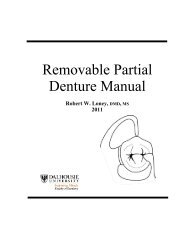Manuals_files/CD Manual 12.pdf - Removable Prosthodontics
Manuals_files/CD Manual 12.pdf - Removable Prosthodontics
Manuals_files/CD Manual 12.pdf - Removable Prosthodontics
You also want an ePaper? Increase the reach of your titles
YUMPU automatically turns print PDFs into web optimized ePapers that Google loves.
Selecting & Setting Teeth - 52<br />
f) Disadvantages: Poorer appearance (non-anatomic teeth); can be unstable if the<br />
condylar guidance is steep (posterior teeth separate, leaving only the anteriors in<br />
contact)<br />
g) Contraindications: The patient has high expectations for improved appearance,<br />
very steep condylar guidance may make a monoplane scheme less stable, unless<br />
modifying ramps or compensating curves are used.<br />
Setting Posterior Teeth:<br />
- Posterior teeth are set for function, while the anterior teeth are set mainly for esthetics<br />
and phonetics (although placement can affect incising ability and fulcruming potential<br />
of the denture)<br />
- Stability is increased when centric contacts are on flat surfaces, rather than on inclines<br />
- The most important cusp in the posterior setup is the maxillary lingual cusp which is set<br />
over the middle of the mandibular ridge (mandibular central fossae will be placed<br />
here)<br />
- Ensure 1-2 mm of overjet in order to prevent cheek or lip biting<br />
- Mandibular buccal cusps are lateral to the residual ridge and have more tipping potential<br />
for the lower denture<br />
- For a lingualized setup, there should be 1mm separation of the maxillary and<br />
mandibular BUCCAL cusps















